The document discusses digital image processing and two-dimensional transforms. It provides an agenda that covers two-dimensional mathematical preliminaries and two transforms: the discrete Fourier transform (DFT) and discrete cosine transform (DCT). It then discusses the DFT and DCT in more detail over several pages, covering properties, examples, and applications such as image compression.
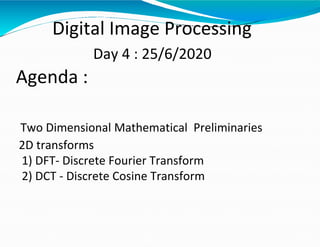

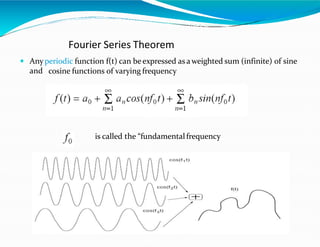



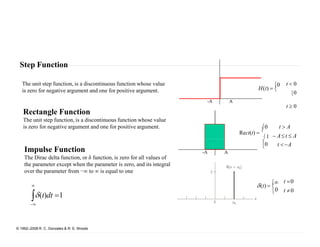




![
AA
X
0
1]
0
vY](https://image.slidesharecdn.com/day4imagetransform-200627104344/85/DIGITAL-IMAGE-PROCESSING-Day-4-Image-Transform-12-320.jpg)

![Discrete Fourier Transform
•Let us discretize a continuous function f(x) into the N uniform
samples that generate the sequence
f(x0), f(x0+Δx), f(x0+2Δx), f(x0+3Δx), …, f(x0+[N-1]Δx)
•Hence f(x) = f(x0+i Δx)
•We could denote the samples as f(0), f(1), f(2), …,f(N-1).
x0
and
0,1,2,..., N 1
N 1
1
f(x)e j 2ux / N
;u
N
• The Fourier Transform is
F (u)
N1
Third Video - Examples
f (x) F(u)e j2ux/ N
u0](https://image.slidesharecdn.com/day4imagetransform-200627104344/85/DIGITAL-IMAGE-PROCESSING-Day-4-Image-Transform-14-320.jpg)







![Properties of 2D Fourier Transform
Symmetry
The Fourier transform of a real function f(x,y) is conjugate symmetric
F*
(u,v) F(u,v)
The Fourier transform of a imaginary function f(x,y) is conjugate anti-symmetric
F*
(u,v) F(u,v)
1
*
x0 y 0NM
F*
(u,v)
M 1N1
f (x, y)e j2 (ux / M vy/ N )
Proof
NM x0 y 0
1 N1
1 M
f *
(x, y)ej2 (ux/ M vy/ N )
1 N1
1 M
f (x, y)e j2 ([u]x/ M [v]y / N )
NM
F(u,v)
x0 y 0](https://image.slidesharecdn.com/day4imagetransform-200627104344/85/DIGITAL-IMAGE-PROCESSING-Day-4-Image-Transform-22-320.jpg)






![Sampling Theorem
Band limited-A function f(t) whose Fourier transform is zero out
of the interval [-max , max] is called band limited
~
We can recover a function f(t) from its sampled
representation if we can isolate a copy of F() from
the periodic sequence of copies.
Extracting from F() a single period that represents
F() is possible in the separation between copies is
sufficient , which is guaranteed if ½T > max
max 2
1
T
Which is call the Nyquist Rate
© 1992–2008 R. C. Gonzalez & R. E. Woods](https://image.slidesharecdn.com/day4imagetransform-200627104344/85/DIGITAL-IMAGE-PROCESSING-Day-4-Image-Transform-29-320.jpg)


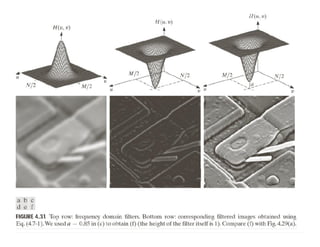
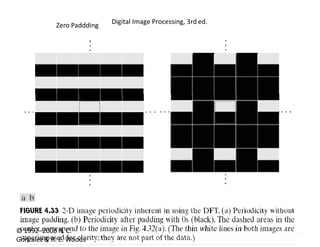















![Quantizer
• it is a function of this type
– inputs in a given range are mapped
to the same output
• to implement this, we
– 1) define a quantizer step size Q
– 2) apply a rounding function
x
Q
x roundq
– the larger the Q, the less reconstruction levels we have
– more compression at the cost of larger distortion
– e.g. for x in [0,255], we need 8 bits and have 256 color values
– 4 levels and only need 2 bits](https://image.slidesharecdn.com/day4imagetransform-200627104344/85/DIGITAL-IMAGE-PROCESSING-Day-4-Image-Transform-49-320.jpg)







![Energy compaction
• The two extensions are
DFT DCT
– note that in the DFT case the extension introduces
discontinuities
– this does not happen for the DCT, due to the symmetry of y[n]
– the elimination of this artificial discontinuity, which contains a lot
of high frequencies,
– is the reason why the DCT is much more efficient](https://image.slidesharecdn.com/day4imagetransform-200627104344/85/DIGITAL-IMAGE-PROCESSING-Day-4-Image-Transform-57-320.jpg)
![2D-DCT
n2n2
1D-DCT
• 1) create
intermediate
sequence by
computing
1D-DCT of
rows
• 2) compute
k1
f [ k1 , n 2 ]
n1
x[ n1 , n 2 ]
1D-DCT of
columns
n2
k2
1D-DCT
k1
f [ k 1 , n 2 ]
5
8
k1
C x [ k 1 , k 2 ]
• the extension to 2D is trivial
• the procedure is the same](https://image.slidesharecdn.com/day4imagetransform-200627104344/85/DIGITAL-IMAGE-PROCESSING-Day-4-Image-Transform-58-320.jpg)